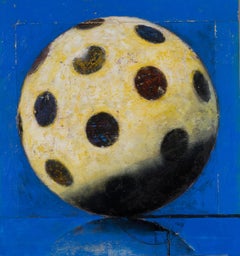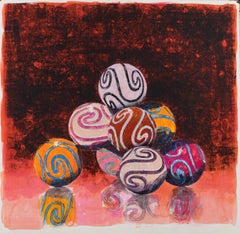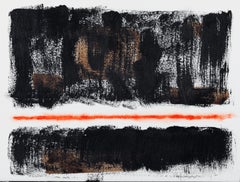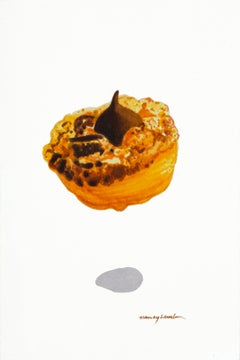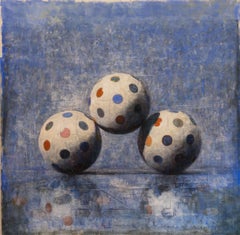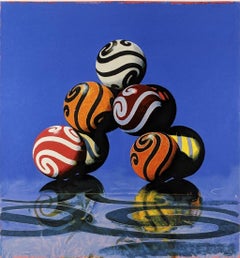John Gibson Art
American, b. 1958
John Gibson has been painting delicate still-life arrangements of balls since the 1990s. This focused body of work originated from his desire to depict 3-dimensionality within the constraints of a 2-dimensional surface successfully. Playing around with patterned surfaces and carefully organizing his subject matter, Gibson builds a subtle complexity within his compositions. In this way, Gibson’s work is similar to that of Italian painter Giorgio Morandi, whose still-life of earthenware objects served as a constant influence.
Within Gibson’s paint handling, there is an evident physicality, making clear a sense of precision and geometry that reflects an architectural quality. This quality is further illustrated by the strong use of light and shadow to create depth within the pictorial plane.
John Gibson received his undergraduate degree from the Rhode Island School of Design, after which he attended Yale University to receive his MFA.(Biography provided by Lincoln Center Editions)
to
1
7
5
1
1
2
1
4
Overall Height
to
Overall Width
to
1
1
1
3
2
2
1
1
1
1
7
7
6,857
3,171
2,516
1,217
5
3
2
1
Artist: John Gibson
Land Fall, by John Gibson (screen print of stacked colorful spheres)
By John Gibson (b. 1958)
Located in New York, NY
This print has a deep blue background and brightly colored red and orange billiards balls.
John Gibson has been painting delicate still-life arrangements of balls since the 1990s. T...
Category
Early 2000s Photorealist John Gibson Art
Materials
Screen
Bailey
By John Gibson (b. 1958)
Located in Lincoln, MA
John Gibson is a native of Massachusetts, born in Boston in 1958. He attended the Rhode Island School of design (where he earned a BFA in 1980), before earning his post-graduate degree from the prestigious master’s program at Yale. Gibson had his first one-man show at the University of Massachusetts in 1984, and he began showing in group exhibitions in the Boston and New York areas in the late 1980s. In the early 1990s Gibson’s paintings began to focus on pyramidal compositions of spheres resembling children’s playground balls, decorated in the manner of colorful soccer balls. Executed in oil on wooden panel, these pieces began to attract generous critical praise for Gibson from the pages of the Boston Globe, the Partisan Review, and the New Yorker, among others. Gibson’s paintings are filled with subtle yet provocative disjunctions, which challenge the viewer’s initial perceptions of the pieces. While these images would seem at first to be fairly simple atmospheric, realistic renderings of colorful balls, a closer examination will reveal that the surfaces of Gibson’s paintings are deeply scored by the artist in geometric patterns that sometimes conform to, and in other instances defy, the outlines of the spheres rendered in paint. An invisible substructure is suggested in these incisions, which also serve to reinforce the physicality of the painting. Some pieces also include incised and/or painted suggestions of shadowy architectural spaces (arches, hallways, shallow niches) in which the balls are placed. The scale of the objects rendered is ultimately unclear: the balls could be of the large, inflatable type, but they alternatively suggest the density of much smaller decorated wooden croquet balls...
Category
2010s Abstract Geometric John Gibson Art
Materials
Oil
Bushwick
By John Gibson (b. 1958)
Located in Lincoln, MA
John Gibson is a native of Massachusetts, born in Boston in 1958. He attended the Rhode Island School of design (where he earned a BFA in 1980), before earning his post-graduate degree from the prestigious master’s program at Yale. Gibson had his first one-man show at the University of Massachusetts in 1984, and he began showing in group exhibitions in the Boston and New York areas in the late 1980s. In the early 1990s Gibson’s paintings began to focus on pyramidal compositions of spheres resembling children’s playground balls, decorated in the manner of colorful soccer balls. Executed in oil on wooden panel, these pieces began to attract generous critical praise for Gibson from the pages of the Boston Globe, the Partisan Review, and the New Yorker, among others. Gibson’s paintings are filled with subtle yet provocative disjunctions, which challenge the viewer’s initial perceptions of the pieces. While these images would seem at first to be fairly simple atmospheric, realistic renderings of colorful balls, a closer examination will reveal that the surfaces of Gibson’s paintings are deeply scored by the artist in geometric patterns that sometimes conform to, and in other instances defy, the outlines of the spheres rendered in paint. An invisible substructure is suggested in these incisions, which also serve to reinforce the physicality of the painting. Some pieces also include incised and/or painted suggestions of shadowy architectural spaces (arches, hallways, shallow niches) in which the balls are placed. The scale of the objects rendered is ultimately unclear: the balls could be of the large, inflatable type, but they alternatively suggest the density of much smaller decorated wooden croquet balls...
Category
2010s Contemporary John Gibson Art
Materials
Oil
Untitled
By John Gibson (b. 1958)
Located in Lincoln, MA
oil on collaged panel
Category
2010s John Gibson Art
Materials
Oil
Untitled
By John Gibson (b. 1958)
Located in Lincoln, MA
oil on collaged panel
Category
2010s John Gibson Art
Florence no.7
By John Gibson (b. 1958)
Located in Lincoln, MA
watercolor on paper
Category
Early 2000s John Gibson Art
Materials
Watercolor
Florence no.8
By John Gibson (b. 1958)
Located in Lincoln, MA
watercolor on paper
Category
2010s John Gibson Art
Materials
Watercolor
Related Items
Thread
By Ed Touchette
Located in Gloucester, MA
Ed Touchette (b. 1948) is inspired by a love of architecture and public spaces to make paintings which express joyful wonder at our built environment — ol...
Category
2010s Bauhaus John Gibson Art
Materials
Ink, Acrylic, Watercolor
Contemporary American Still Life of Hershey's Kiss Cake, Chocolate Dessert Treat
By Nancy Lamb
Located in Fort Worth, TX
Nancy Lamb, Kiss Cake, 2020, Watercolor on Paper, 5.5 x 3.5."
Contemporary American Still Life of Hershey's Kiss Cake, Chocolate Dessert Treat.
This fan...
Category
21st Century and Contemporary American Realist John Gibson Art
Materials
Watercolor, Paint, Paper
Untitled _ ''White Inferno'' series.
Located in T'bilisi, GE
The "White Inferno" series features crafted mixed media artworks, blending diverse mediums to create intense visual compositions. Incorporating collage p...
Category
21st Century and Contemporary Contemporary John Gibson Art
Materials
Paint, Charcoal, Ink, Mixed Media, Oil, Spray Paint, Acrylic, Archival P...
'Untitled' Abstract Geometric Wall Piece Wood/Paint/Textile Black, White, Grays
By Jean Feinberg
Located in Wellesley, MA
ADDITIONAL PHOTOS OF THIS WORK WILL BE SENT UPON REQUEST.
NOTE COLOR OF WOOD IS NOT QUITE AS YELLOW AS IIT APPEARS IN PHOTO AND IS IN KEEPING WITH OTHERS IN THIS SERIES:
Jean Fein...
Category
2010s Abstract Geometric John Gibson Art
Materials
Gesso, Oil, Wood Panel, Muslin
The Abduction of the Sabine Women , a Renaissance drawing by Biagio Pupini
Located in PARIS, FR
This vigorous drawing has long been attributed to Polidoro da Caravaggio: The Abduction of the Sabine Women is one of the scenes that Polidoro depicted between 1525 and 1527 on the façade of the Milesi Palazzo in Rome. However, the proximity to another drawing inspired by this same façade, kept at the Ecole des Beaux-Arts, and to other drawings inspired by Polidoro kept at the Musée du Louvre, leads us to propose an attribution to Biagio Pupini, a Bolognese artist whose life remains barely known, despite the abundant number of drawings attributed to him.
1. Biagio Pupini, a Bolognese artist in the light of the Roman Renaissance
The early life of Biagio Pupini, an important figure of the first half of the Cinquecento in Bologna - Vasari mentions him several times - is still poorly known. Neither his date of birth (probably around 1490-1495) nor his training are known. He is said to have been a pupil of Francesco Francia (1450 - 1517) and his name appears for the first time in 1511 in a contract with the painter Bagnacavallo (c. 1484 - 1542) for the frescoes of a church in Faenza. He then collaborated with Girolamo da Carpi, at San Michele in Bosco and at the villa of Belriguardo.
He must have gone to Rome for the first time with Bagnacavallo between 1511 and 1519. There he discovered the art of Raphael, with whom he might have worked, and that of Polidoro da Caravaggio. This first visit, and those that followed, were the occasion for an intense study of ancient and modern art, as illustrated by his abundant graphic production.
Polidoro da Caravaggio had a particular influence on the technique adopted by Pupini. Executed on coloured paper, his drawings generally combine pen, brown ink and wash with abundant highlights of white gouache, as in the drawing presented here.
2. The Abduction of the Sabine Women
Our drawing is an adaptation of a fresco painted between 1525 and 1527 by Polidoro da Caravaggio on the façade of the Milesi Palace in Rome. These painted façades were very famous from the moment they were painted and inspired many artists during their stay in Rome. These frescoes are now very deteriorated and difficult to see, as the palace is in a rather narrow street.
The episode of the abduction of the Sabine women (which appears in the centre of the photo above) is a historical theme that goes back to the origins of Rome and is recounted both by Titus Livius (Ab Urbe condita I,13), by Ovid (Fasti III, 199-228) and by Plutarch (II, Romulus 14-19). After killing his twin brother Romus, Romulus populates the city of Rome by opening it up to refugees and brigands and finds himself with an excess of men. Because of their reputation, none of the inhabitants of the neighbouring cities want to give them their daughters in marriage. The Romans then decide to invite their Sabine neighbours to a great feast during which they slaughter the Sabines and kidnap their daughters.
The engraving made by Giovanni Battista Gallestruzzi (1618 - 1677) around 1656-1658 gives us a good understanding of the Polidoro fresco, allowing us to see how Biagio Pupini reworked the scene to extract this dynamic group.
With a remarkable economy of means, Biagio Pupini takes over the left-hand side of the fresco and depicts in a very dense space two main groups, each consisting of a Roman and a Sabine, completed by a group of three soldiers in the background (which seems to differ quite significantly from Polidoro's composition).
The balance of the drawing is based on a very strongly structured composition. The drawing is organised around a median vertical axis, which runs along both the elbow of the kidnapped Sabine on the left and the foot of her captor, and the two main diagonals, reinforced by four secondary diagonals. This diamond-shaped structure creates an extremely dynamic space, in which centripetal movements (the legs of the Sabine on the right, the arm of the soldier on the back at the top right) and centrifugal movements (the arm of the kidnapper on the left and the legs of the Sabine he is carrying away, the arm of the Sabine on the right) oppose each other, giving the drawing the appearance of a whirlpool around a central point of support situated slightly to the left of the navel of the kidnapper on the right.
3. Polidoro da Caravaggio, and the decorations of Roman palaces
Polidoro da Caravaggio was a paradoxical artist who entered Raphael's (1483 - 1520) workshop at a very young age, when he oversaw the Lodges in the Vatican. Most of his Roman work, which was the peak of his career, has disappeared, as he specialised in facade painting, and yet these paintings, which are eminently visible in urban spaces, have influenced generations of artists who copied them abundantly during their visits to Rome.
Polidoro Caldara was born in Caravaggio around 1495-1500 (the birthplace of Michelangelo Merisi, known as Caravaggio, who was born there in 1571), some forty kilometres east of Milan. According to Vasari, he arrived as a mason on the Vatican's construction site and joined Raphael's workshop around 1517 (at the age of eighteen according to Vasari). This integration would have allowed Polidoro to work not only on the frescoes of the Lodges, but also on some of the frescoes of the Chambers, as well as on the flat of Cardinal Bibiena in the Vatican.
After Raphael's death in 1520, Polidoro worked first with Perin del Vaga before joining forces with Maturino of Florence (1490 - 1528), whom he had also known in Raphael's workshop. Together they specialised in the painting of palace façades. They were to produce some forty façades decorated with grisaille paintings imitating antique bas-reliefs.
The Sack of Rome in 1527, during which his friend Maturino was killed, led Polidoro to flee first to Naples (where he had already stayed in 1523), then to Messina. It was while he was preparing his return to the peninsula that he was murdered by one of his assistants, Tonno Calabrese, in 1543.
In his Vite, Vasari celebrated Polidoro as the greatest façade decorator of his time, noting that "there is no flat, palace, garden or villa in Rome that does not contain a work by Polidoro". Polidoro's facade decorations, most of which have disappeared as they were displayed in the open air, constitute the most important lost chapter of Roman art of the Cinquecento. The few surviving drawings of the painter can, however, give an idea of the original appearance of his murals and show that he was an artist of remarkable and highly original genius.
4. The façade of the Milesi Palace
Giovanni Antonio Milesi, who commissioned this palace, located not far from the Tiber, north of Piazza Navona, was a native of the Bergamo area, like Polidoro, with whom he maintained close friendly ties. Executed in the last years before the Sack of Rome, around 1526-1527, the decoration of Palazzo Milesi is considered Polidoro's greatest decorative success.
An engraving by Ernesto Maccari made at the end of the nineteenth century allows us to understand the general balance of this façade, which was still well preserved at the time. The frescoes were not entirely monochrome, but alternated elements in chiaroscuro simulating marble bas-reliefs and those in ochre simulating bronze and gold vases...
Category
16th Century Old Masters John Gibson Art
Materials
Ink, Gouache, Pen
Roxy
By Robert Cottingham
Located in New York, NY
Color offset lithograph. Signed and numbered 2/100 in pencil by Cottingham.
This work is based on the same-titled color screenprint by Cottingham.
Category
Early 2000s Photorealist John Gibson Art
Materials
Color, Lithograph, Offset
Abstract Watercolor N.8 by Dmitry Samygin
By Dmitry Samygin
Located in Paris, FR
Abstract Watercolor N.8 by Dmitry Samygin
Minimalist and geometric paintings.
Technique: Watercolor
Color: Teal blue
Size: H. 35.5 x 27.5 x 0.1 cm
Dmitry Samygin is a Furniture a...
Category
21st Century and Contemporary Abstract Geometric John Gibson Art
Materials
Watercolor
Humming Bird II
By Jamel Akib
Located in Battle, East Sussex
Jamel Akib
Born in Leigh-on-sea, Essex in 1965 to English and Malaysian parents, Jamel moved to North Borneo at the age of five. At thirteen he returned to England to pursue his edu...
Category
21st Century and Contemporary Contemporary John Gibson Art
Materials
Canvas, Oil
VAN BIESBROECK Jules. Snake charmer. Oil on panel. Signed.
By Jules Pierre van Biesbroeck
Located in Paris, FR
Algerian women in an interior. Oil on panel. Signed.
This work will be recorded in the catalogue raisonné of the work of the artist currently in preparation.
Jules Van Biesbroeck...
Category
1920s John Gibson Art
Materials
Oil
H 19.69 in Dm 15.75 in
Victoria Sponge Cake Risograph Print
Located in Collingwood, Victoria
In this series Alice explores the graphic qualities of cakes and the romance of cake shops using a combination of printmaking techniques. Working with layered silkscreens, stencillin...
Category
2010s Other Art Style John Gibson Art
Materials
Screen
Raspberry Rose Royale Cake Screen Print
Located in Collingwood, Victoria
In this series Alice explores the graphic qualities of cakes and the romance of cake shops using a combination of printmaking techniques. Working with layered silkscreens, stencilling, risograph printing, stamping and collage, this new body of work looks at the textures, garish decorations, and their fanciful presentation in the cake shop window.
Cake 64 “Raspberry Rose...
Category
2010s Other Art Style John Gibson Art
Materials
Screen
Coco Cherry Sponge Cake Risograph Print
Located in Collingwood, Victoria
In this series Alice explores the graphic qualities of cakes and the romance of cake shops using a combination of printmaking techniques. Working with layered silkscreens, stencillin...
Category
2010s Other Art Style John Gibson Art
Materials
Screen
Previously Available Items
Felix
By John Gibson (b. 1958)
Located in Lincoln, MA
John Gibson is a native of Massachusetts, born in Boston in 1958. He attended the Rhode Island School of design (where he earned a BFA in 1980), before earning his post-graduate degree from the prestigious master’s program at Yale. Gibson had his first one-man show at the University of Massachusetts in 1984, and he began showing in group exhibitions in the Boston and New York areas in the late 1980s. In the early 1990s Gibson’s paintings began to focus on pyramidal compositions of spheres resembling children’s playground balls, decorated in the manner of colorful soccer balls. Executed in oil on wooden panel, these pieces began to attract generous critical praise for Gibson from the pages of the Boston Globe, the Partisan Review, and the New Yorker, among others. Gibson’s paintings are filled with subtle yet provocative disjunctions, which challenge the viewer’s initial perceptions of the pieces. While these images would seem at first to be fairly simple atmospheric, realistic renderings of colorful balls, a closer examination will reveal that the surfaces of Gibson’s paintings are deeply scored by the artist in geometric patterns that sometimes conform to, and in other instances defy, the outlines of the spheres rendered in paint. An invisible substructure is suggested in these incisions, which also serve to reinforce the physicality of the painting. Some pieces also include incised and/or painted suggestions of shadowy architectural spaces (arches, hallways, shallow niches) in which the balls are placed. The scale of the objects rendered is ultimately unclear: the balls could be of the large, inflatable type, but they alternatively suggest the density of much smaller decorated wooden croquet balls...
Category
2010s Abstract Geometric John Gibson Art
Materials
Oil
Land Fall
By John Gibson (b. 1958)
Located in New York, NY
This print has a deep blue background and brightly colored red and orange billiards balls.
John Gibson has been painting delicate still-life arrangements of balls since the 1990s. T...
Category
Early 2000s Contemporary John Gibson Art
Materials
Screen
Land Fall, Screenprint by John Gibson
By John Gibson (b. 1958)
Located in Long Island City, NY
Artist: John Gibson, American (1958 - )
Title: Land Fall
Year: 2005
Medium: Screenprint, signed and numbered in pencil
Edition: 43/108
Image Size: 30 x 28 inches
Sheet Size: 37 x 3...
Category
Early 2000s Contemporary John Gibson Art
Materials
Screen
John Gibson art for sale on 1stDibs.
Find a wide variety of authentic John Gibson art available for sale on 1stDibs. If you’re browsing the collection of art to introduce a pop of color in a neutral corner of your living room or bedroom, you can find work that includes elements of blue and other colors. You can also browse by medium to find art by John Gibson in paint, oil paint, watercolor and more. Much of the original work by this artist or collective was created during the 21st century and contemporary and is mostly associated with the Photorealist style. Not every interior allows for large John Gibson art, so small editions measuring 13 inches across are available. Customers who are interested in this artist might also find the work of Ralph Anderson, Gloria Matuszewski, and Travis Rice. John Gibson art prices can differ depending upon medium, time period and other attributes. On 1stDibs, the price for these items starts at $2,800 and tops out at $2,800, while the average work can sell for $2,800.




